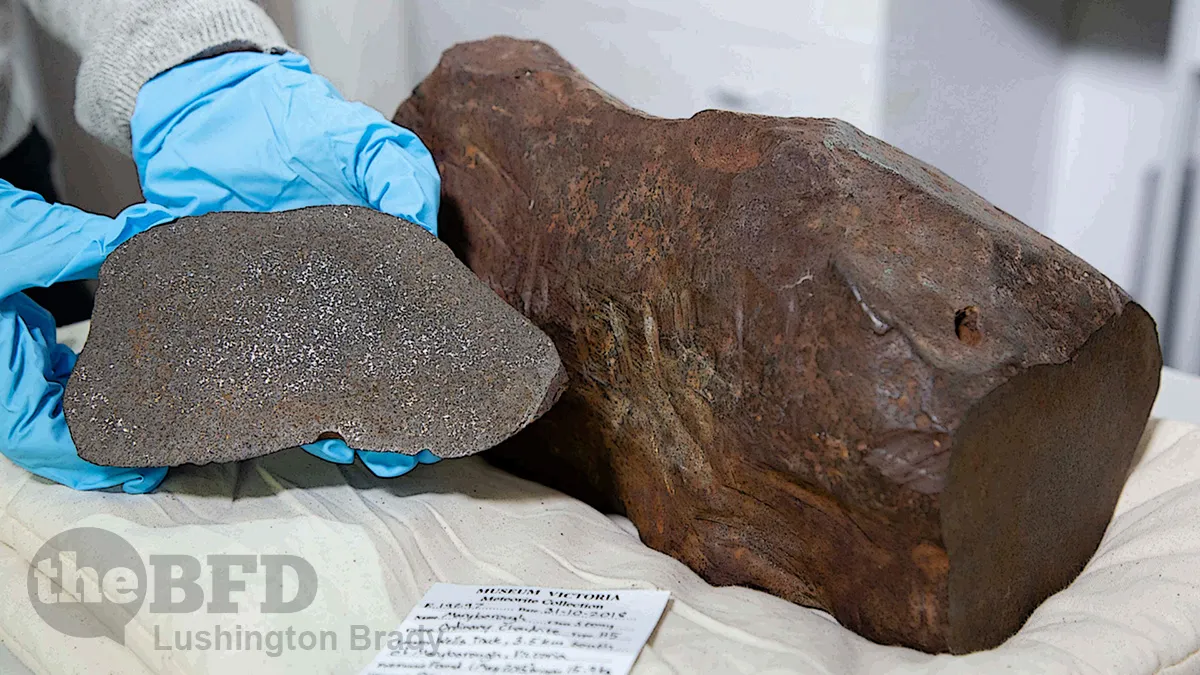In Douglas Adams’ classic The Meaning of Liff, a glassel is defined as “A seaside pebble which was shiny and interesting when wet, and which is now a lump of rock, which children nevertheless insist on filing [sic] their suitcases with after the holiday.”
Our house has more than its share of glassels, although my eldest, courtesy of a rock tumbler, has found a way to make them shiny and interesting again. There are also a handful that, while not shiny, are definitely interesting, such as the small-pumpkin-sized mass of Permian fossils carted home in yours truly’s backpack. Still, their value is mostly as curios.
Unlike some other people’s glassels.
In 2015, David Hole was prospecting in Maryborough Regional Park near Melbourne, Australia.
Armed with a metal detector, he discovered something out of the ordinary – a very heavy, reddish rock resting in some yellow clay.
He took it home and tried everything to open it, sure that there was a gold nugget inside the rock – after all, Maryborough is in the Goldfields region, where the Australian gold rush peaked in the 19th century.
But, like the McGuffin of an SF/horror story, the strange rock refused to break. Rock saw, angle grinder, grill, dousing it in acid and even smashing at it with a sledgehammer: nothing could crack it. So, no gold nugget.
Because, as it turned out, it was something even more valuable.
When Hole took it to the Melbourne Museum, years later, it was identified as a rare meteorite.
After 37 years of working at the museum and examining thousands of rocks, [Melbourne Museum geologist Dermot Henry] said only two of the offerings had ever turned out to be real meteorites.
This was one of the two.
Its unusual weight was the first clue.
“It had this sculpted, dimpled look to it,” Melbourne Museum geologist Dermot Henry told the Sydney Morning Herald in 2019.
“That’s formed when they come through the atmosphere, they are melting on the outside, and the atmosphere sculpts them.”
The meteorite, dubbed Maryborough, is an H5 ordinary chondrite, a common class of meteorite with a high percentage of iron. Henry and fellow Melbourne Museum geologist, Bill Birch, suspect that the meteorite is a 4.6 billion year old chunk of leftover from the formation of the Solar System.
Our Solar System was once a spinning pile of dust and chondrite rocks. Eventually gravity pulled a lot of this material together into planets, but the leftovers mostly ended up in a huge asteroid belt.
“This particular meteorite most probably comes out of the asteroid belt between Mars and Jupiter, and it’s been nudged out of there by some asteroids smashing into each other, then one day it smashes into Earth,” Henry told Channel 10 News.
Science Alert
How long ago it made Earthfall is uncertain, but carbon dating suggests between 100 and 1,000 years. There have been a number of meteor sightings between 1889 and 1951 that could correspond to its arrival.
And despite being the most common type of meteorite, it’s still very rare – and valuable.
The researchers argue that the Maryborough meteorite is much rarer than gold, making it far more valuable to science. It’s one of only 17 meteorites ever recorded in the Australian state of Victoria, and it’s the second largest chondritic mass, after a huge 55-kilogram specimen identified in 2003.
A similar meteorite, the sixth-largest ever discovered, was found in Michigan 80 years ago. In that time, it spent 30 years as a doorstop before its owner had it identified.
And evaluated at anywhere up to $100,000.
So, if you’ve got any weird, heavy rocks lying around, you never know. But, bear in mind Henry’s admission that only two rocks he’d examined in 37 years turned out to be actual meteorites.









